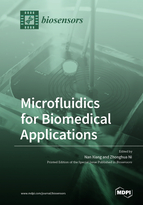Microfluidics for Biomedical Applications
A special issue of Biosensors (ISSN 2079-6374). This special issue belongs to the section "Biosensors and Healthcare".
Deadline for manuscript submissions: closed (31 December 2022) | Viewed by 53729
Special Issue Editors
Interests: inertial microfluidics; soft robotics; microfluidic cell separation; viscoelastic microfluidics; point-of-care testing device; microflow cytometer; microfluidic valve; dielectrophoresis
Special Issues, Collections and Topics in MDPI journals
Interests: microfluidics; biomedical microdevices; biosensors
Special Issues, Collections and Topics in MDPI journals
Special Issue Information
Dear Colleagues,
Microfluidics is a technique of controlling the behavior of fluids or bioparticles in microscale channels or spaces. The advent of microfluidics has provided new insights into the fields of biomedical research and clinical diagnosis. Compared with conventional techniques, microfluidics offers various advantages, such as low sample consumption, high efficiency, small device footprint, multifunction integration, and high manipulation resolution. To date, microfluidics has been employed for a range of biomedical applications, such as efficient sample pretreatment, single-cell analysis, high-throughput microflow cytometry, organ-on-a-chip, and biosensing. As a result, great improvements have been achieved in modern biomedical diagnosis and research. For example, the isolation and detection of rare circulating tumor cells (CTCs) from the peripheral blood have served as a noninvasive “virtual and real-time liquid biopsy” and are of great significance for the early diagnosis, personalized treatment, and therapeutic efficacy monitoring of cancers. On the basis of these applications, various point-of-care testing (POCT) devices have been invented, among which some are successfully commercialized. This Special Issue is devoted to the most recent technical innovations and developments in the area of microfluidics, in particular, for biomedical applications.
Scope of the Special Issue:
Fluid and cell manipulation via microfluidics;
Novel channel invention for new applications;
Fabrication methods for new functions;
Microfluidics-based point-of-care testing (POCT) devices;
Microfluidics for biotarget sensing and single cell analysis;
Application of microfluidics in biomedical applications.
This Special Issue aims to highlight the most recent advances of microfluidics for biomedical applications. Reviews and original research papers are all welcome.
Prof. Dr. Nan Xiang
Prof. Dr. Zhonghua Ni
Guest Editors
Manuscript Submission Information
Manuscripts should be submitted online at www.mdpi.com by registering and logging in to this website. Once you are registered, click here to go to the submission form. Manuscripts can be submitted until the deadline. All submissions that pass pre-check are peer-reviewed. Accepted papers will be published continuously in the journal (as soon as accepted) and will be listed together on the special issue website. Research articles, review articles as well as short communications are invited. For planned papers, a title and short abstract (about 100 words) can be sent to the Editorial Office for announcement on this website.
Submitted manuscripts should not have been published previously, nor be under consideration for publication elsewhere (except conference proceedings papers). All manuscripts are thoroughly refereed through a single-blind peer-review process. A guide for authors and other relevant information for submission of manuscripts is available on the Instructions for Authors page. Biosensors is an international peer-reviewed open access monthly journal published by MDPI.
Please visit the Instructions for Authors page before submitting a manuscript. The Article Processing Charge (APC) for publication in this open access journal is 2700 CHF (Swiss Francs). Submitted papers should be well formatted and use good English. Authors may use MDPI's English editing service prior to publication or during author revisions.
Keywords
- microfludics
- cell manipulation and detection
- point-of-care testing
- lab on a chip
- biomedical applications







